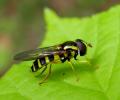(by Tony Irwin) Sunday 27 May 2007 was a dull, cold day and I nearly didn't take my camera on the dog walk. There was very little of interest in the woods until we came to an old ash (Fraxinus excelsior) tree which had lots of beetle (Anobium?) emergence holes. Beside the holes sat a female Neurigona quadrifasciata (Dolichopodidae). As I was getting the camera ready, a male appeared and rapidly approached her from behind, waving his wings rapidly.
He stepped up to the female from behind, with his abdomen and his fore legs raised and with his mid and hind legs just behind the female's mid and hind legs. His wings were in constant motion (Figure 1).

Gradually he lowered his forelegs down beside the female's head, so that she could see the pennate black and white tarsal segments on either side. He also stepped back slightly with his hind legs (Figures 2-4).



Presumably he was satisfied that the female recognised him as a suitable mate, and he stepped further back with his hind legs and at the same time pulled his forelegs back so that they rested on the female's wings, just behind her thorax. His abdomen was lowered and began to curl under the female (Figure 5).

His wings stopped moving, his abdomen extended forwards and the claspers opened and shut (Figure 6-8).



Suddenly he grasped the female's abdomen (Figure 9), then adjusted his position by straightening up slightly (Figure 10).


At this point they began to move off together towards the beetle burrows, and I caught them.
Nearly fifty years ago, Ken Smith recorded the mating behaviour of Neurigona (1959, Entomologists' Monthly Magazine 95: 32-33), but it was still satisfying to discover it for myself. It is particularly pleasing to see a male dolichopodid actually using its modified tarsi to communicate with a female.
Interestingly, Ken's account differs from mine in a few details. He recorded the male waving its fore-tarsi alternately in front of each eye. I was too busy taking shots to notice, but from the pictures, it appears that the tarsi are lowered at the same time. Also Ken noticed that the wing waving started slowly, only speeding up when the abdomen curved under the female, then stopping on copulation. With mine, the male wings were beating rapidly, but stopped when the male curved its abdomen under the female. Another difference was that Ken's male continued its tarsal display until copulation, only then did it draw its fore-tarsi back on to the female.
I wonder whether these were just differences between individuals, or are there local differences, or did I observe a 21st century approach to courtship? Unless I have the dedication of someone like Nikita (see his article on Medetera courtship), I don't think I'm likely to find out!
The photos were all taken hand-held, without flash, at 1/100th second, aperture 6.3 to 7.1, using a Canon EFS 60mm macro on a Canon EOS350D.













 BTW: That's done now.
BTW: That's done now.


It's very noble of you to spare me the embarassment of admitting I took these indifferent photos, but I can't stand by and let you take all the criticism!
It was me folks!